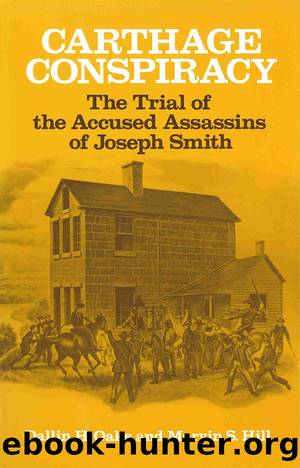Carthage Conspiracy by Dallin H Oaks

Author:Dallin H Oaks
Language: eng
Format: epub
Publisher: University of Illinois Press
* * *
1. Attachment in court files, People v. Levi Williams; Circuit Court Record, 276.
2. Circuit Court Record, 260, 276; copy of Ford subpoena in case file, People v. Levi Williams; âMinutes of Trial,â 37.
3. Missouri Republican, May 27, 1845.
4. Watt Manuscript, 5. The opening arguments are also described briefly in âMinutes of Trial,â 37.
5. Watt Manuscript, 6.
6. Ibid., 7.
7. Ibid., 7-8.
8. Ibid., 9.
9. Deputy sheriff's May 21, 1845, certification on attachment for Henry Matthews, in case file, People v. Levi Williams.
10. Baxter, Browning, 11, 51, 288; Doyle, âJosiah Lamborn,â 185-200.
11. People v. Brennan, 15 Illinois Reports 511, 517 (1854).
12. âMinutes of Trial,â 37.
13. Watt Manuscript, 12; accord, âMinutes of Trial,â 38.
14. Watt Manuscript, 11-12; âDocuments,â 1.
15. John Peyton owned a farm about three miles south of Warsaw. One of the earliest settlers in the county, he had come from Kentucky in 1830. His 2,500 acres made him one of the largest landowners in the county. He was also to become one of the first township supervisors of his area, and to be elected again and again to that position. Gregg, History of Hancock County, 648-49, 671; Hancock County Census, 1850, p. 442.
George Walker was also an early settler; he had come to Hancock County from Kentucky in 1833 with his wife and four children, settling on a farm about five miles southeast of Warsaw. The township of Walker was named for him. An ordained Baptist minister, he erected a log church building on his farm at his own expense. At the time of the trial he was an elected justice of the peace, and a few months after the trial he was the unanimously elected candidate for a three-year term as county commissioner. A Democrat, Walker was later elected to two terms in the legislature. Thomas Gregg, county historian, says Walker was âa man of deep religious convictions [and] of sterling integrityâ (Gregg, History of Hancock County, 350, 450, 971-72; Scofield, History of Hancock County, 1102; Election Returns, 56:64; Hancock County Census, 1850, p. 295-A).
16. Since there were no completed railroads in Hancock County in 1845, the ârailroad shantiesâ that figure prominently in this narrative were probably structures left over from construction work on the railroad that was to run from Peoria through Macomb to Carthage and thence to Warsaw along the Carthage-Warsaw road. Construction had been halted in 1839 due to lack of funds. Cochran, History of Hancock County, 584.
17. Watt Manuscript, 14.
18. Ibid., 13; accord, âMinutes of Trial,â 39; âDocuments,â 2.
19. âMinutes of Trial,â 39; accord, Watt Manuscript, 15.
20. Watt Manuscript, 13.
21. Ibid., 14-15; accord, âMinutes of Trial,â 39.
22. Watt Manuscript, 16-17; accord, âDocuments,â 3; âMinutes of Trial,â 39.
23. Smith, History of the Church, VI, 595.
24. Ibid., 602.
25. Watt Manuscript, 18; âDocuments,â 3-4; âMinutes of Trial,â 41.
26. âMinutes of Trial,â 41; accord, Watt Manuscript, 18-19.
27. âDocuments,â 3; accord, âMinutes of Trial,â 41; Watt Manuscript, 17-19.
28. âMinutes of Trial,â 41; accord, Watt Manuscript, 19.
29. Hay, âThe Mormon Prophet's Tragedy,â 669, 675. John Hay had grown up in Warsaw. His father, Charles Hay, was the surgeon of Colonel Levi Williams's regiment of militia.
Download
This site does not store any files on its server. We only index and link to content provided by other sites. Please contact the content providers to delete copyright contents if any and email us, we'll remove relevant links or contents immediately.
| Amish | Catholicism |
| Christian Science | Jehovah's Witness |
| Mennonite | Messianic Judaism |
| Mormonism | Orthodoxy |
| Protestantism |
Under the Banner of Heaven: A Story of Violent Faith by Jon Krakauer(1718)
The Early Centuries - Byzantium 01 by John Julius Norwich(1674)
The Amish by Steven M. Nolt(1508)
Taken by J. C. Owens(1508)
In Spirit and Truth (In Spiritu Et Veritate Series) by Reed Zoe(1496)
Play It as It Lays by Joan Didion(1447)
The Apogee - Byzantium 02 by John Julius Norwich(1388)
The Last Man in Russia by Oliver Bullough(1341)
A History of the Amish by Steven M. Nolt(1233)
David Sedaris Diaries by David Sedaris(1194)
Leaving the Witness by Amber Scorah(1181)
Tears of the Silenced: A True Crime and an American Tragedy; Severe Child Abuse and Leaving the Amish by Misty Griffin(1157)
Fallen by unknow(1151)
The Dance of Change by unknow(1134)
The Angel of Forest Hill by Cindy Woodsmall(1102)
The Best of Amish Cooking by Phyllis Pellman Good(1091)
The Ariana Trilogy by Rachel Ann Nunes(1083)
Deep Blue by unknow(1080)
Escape by Carolyn Jessop & Laura Palmer(1066)
